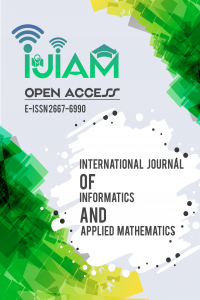Latency and Energy Efficient Routing-Aware TDMA for Wireless Sensor Networks
Latency and Energy Efficient Routing-Aware TDMA for Wireless Sensor Networks
WSNs, Cross-Layer, TDMA, Routing Tree, Hidden Node Problem Energy Consumption, Communication Latency,
___
- I. F. Akyildiz, W. Su, Y. Sankarasubramaniam and E. Cayirci. A survey on sensor networks. IEEE Communications magazine, 40(8):102-114, 2002
- P. Bellavista, G. Cardone, A. Corradi and L. Foschini. Convergence of manet and wsn in iot urban scenarios. IEEE Sensors Journal, 13(10):3558-3567, 2013.
- B. Fu, Y. Xiao, H. J. Deng and H. Zeng. A survey of cross-layer designs in wireless networks. IEEE Communications Surveys and Tutorials, 16(1):110126,2014.
- V. T. Raisinghani and S. Iyer. Cross-layer design optimizations in wireless protocol stacks. Computer communications, 27(8):720-724, 2004.
- V. Srivastava and M. Motani. Cross-layer design: a survey and the road ahead. IEEE communications magazine, 43(12):112-119, 2005.
- D. K. Sah and T. Amgoth. Parametric survey on cross-layer designs for wireless sensor networks. Computer Science Review, 27:112-134, 2018.
- L. Louail and V. Felea. Latency optimization through routing-aware time scheduling protocols for wireless sensor networks. Computers and Electrical Engineering, 56:418-440, 2016.
- C. F. Chou and K.T. Chuang. Colanet: a cross-layer design of energy-efficient wireless sensor networks. In Systems Communications (ICW05, ICHSN05, ICMCS05, SENET05), pages 364-369. IEEE, 2005.
- S. Pemmaraju and S. Skiena. Computational Discrete Mathematics: Combinatorics and Graph Theory with Mathematica. Cambridge university press, 2003.
- L. Louail and V. Felea. Routing-aware time slot allocation heuristics in contention-free sensor networks. In International Conference WWIC, pages 271-283. Springer, 2016.
- W. Osamy, A. A. El-sawy, and Ahmed M Khedr. Satc: A simulated annealing based tree construction and scheduling algorithm for minimizing aggregation time in wireless sensor networks. Wireless Personal Communications, pages 118, 2019.
- E. Triantaphyllou. Multi-criteria decision making methods. In Multi-criteria decision making methods: A comparative study, pages 5-21. Springer, 2000.
- B. N. Clark, C. J. Colbourn and D. S. Johnson. Unit disk graphs. Discrete mathematics, 86(1-3):165-177, 1990.
- J. Long, M. Dong, K. Ota and A. Liu. A green tdma scheduling algorithm for prolonging life-time in wireless sensor networks. IEEE Systems Journal, 11(2):868-877, 2015.
- K. Kosek-Szott. A survey of mac layer solutions to the hidden node problem in ad-hoc networks. Ad Hoc Networks, 10(3):635660, 2012.
- J. OMadadhain, D. Fisher, P. Smyth, S. White and Y.B. Boey. Analysis and visualization of network data using jung. Journal of Statistical Software, 10(2):1-35, 2005.
- M. Abo-Zahhad O. Amin, M. Farrag and A. Ali. Survey on energy consumption models in wireless sensor networks. Open Trans. Wirel. Sens. Netw, 1(1), 2014.
- S. Mijovic, L. Sanguinetti, C. Buratti and M. Debbah. Optimal design of energy-efficient cooperative wsns: How many sensors are needed? In 16th international workshop SPAWC, pages 31-35. IEEE, 2015.
- Başlangıç: 2018
- Yayıncı: International Society of Academicians
Automated Facial Expression Recognition Using Deep Learning Techniques: An Overview
Meriem SARİ, Abdelouahab MOUSSAOUI, Abdenour HADİD
Latency and Energy Efficient Routing-Aware TDMA for Wireless Sensor Networks
İslam Amine BOUCHEDJERA, Lemia LOUAİL
